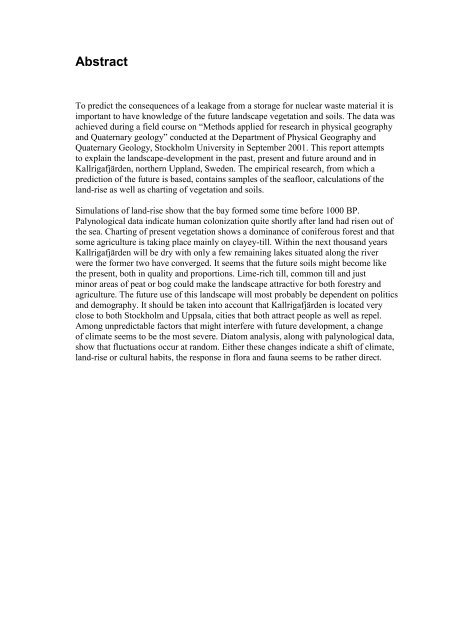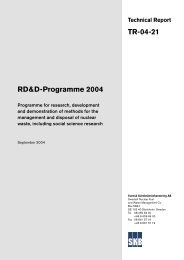Create successful ePaper yourself
Turn your PDF publications into a flip-book with our unique Google optimized e-Paper software.
AbstractTo predict the consequences of a leakage from a storage for nuclear waste material it isimportant to have knowledge of the future landscape vegetation and soils. The data wasachieved during a field course on “Methods applied for research in physical geographyand Quaternary geology” conducted at the Department of Physical Geography andQuaternary Geology, Stockholm University in September 2001. This report attemptsto explain the landscape-development in the past, present and future around and inKallrigafjärden, northern Uppland, Sweden. The empirical research, from which aprediction of the future is based, contains samples of the seafloor, calculations of theland-rise as well as charting of vegetation and soils.Simulations of land-rise show that the bay formed some time before 1000 BP.Palynological data indicate human colonization quite shortly after land had risen out ofthe sea. Charting of present vegetation shows a dominance of coniferous forest and thatsome agriculture is taking place mainly on clayey-till. Within the next thousand yearsKallrigafjärden will be dry with only a few remaining lakes situated along the riverwere the former two have converged. It seems that the future soils might become likethe present, both in quality and proportions. Lime-rich till, common till and justminor areas of peat or bog could make the landscape attractive for both forestry andagriculture. The future use of this landscape will most probably be dependent on politicsand demography. It should be taken into account that Kallrigafjärden is located veryclose to both Stockholm and Uppsala, cities that both attract people as well as repel.Among unpredictable factors that might interfere with future development, a changeof climate seems to be the most severe. Diatom analysis, along with palynological data,show that fluctuations occur at random. Either these changes indicate a shift of climate,land-rise or cultural habits, the response in flora and fauna seems to be rather direct.
















